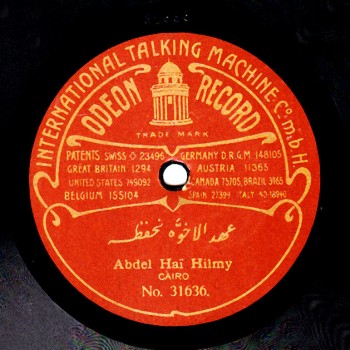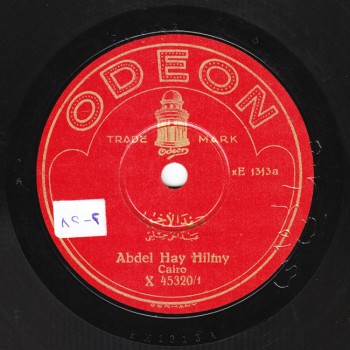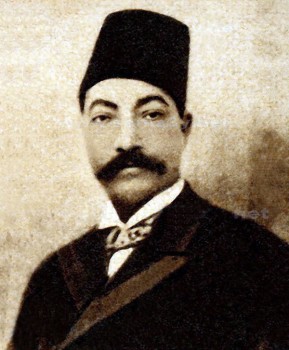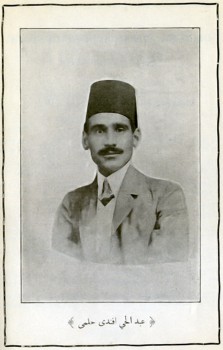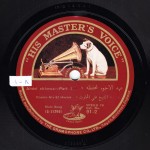The Arab Music Archiving and Research foundation (AMAR), in collaboration with the Sharjah Art Foundation (SAF), presents “Sama‘ ”.
“Sama‘ ” discusses our musical heritage through comparison and analysis…
A concept by Mustafa Said.
Dear listeners,
Welcome to a new episode of “Sama‘ ”.
Today, we will discuss dawr “ ‘Ahd el-ukhuwwa”.
Dawr “ ‘Ahd el-ukhuwwa niḥfaẓu” was written by Ismā‘īl Bāshā Ṣabrī and composed by ‘Abduh al-Ḥāmūlī to the maqām bayyātī ḥusaynī –as categorized by contemporaries. In fact, it is not a maqām ḥusaynī but rather a ḥaraka (a change) added to the maqām bayyātī called bayyā ḥusaynī or bayyātī ḥusaynī… This will be clarified throughout our discussion about the dawr.
Dawr “ ‘Ahd al-ukhuwwa” carries different meanings: its lyrics hide, in between its lines, meanings that are not clearly expressed. Ismā‘īl Bāshā Ṣabrī was close to khedive Ismā‘īl as well as to ‘Abd al-Lāh al-Nadīm, and this dawr tells about a cultural / intellectual / artistic club… a group of friends or “brothers” including Imām Muḥammad ‘Abduh, ‘Abd al-Lāh al-Nadīm, ‘Abduh al-Ḥāmūlī, Ismā‘īl Ṣabrī, Qurrā‘a, Muḥammad Darwīsh… a large group of people who met in different places, each holding talks, and discussing various subjects… It is said that there were also musicians, such as Muḥammad al-‘Aqqād.
The point is that at a later stage, when ‘Abd al-Lāh al-Nadīm became a fugitive wanted by the authorities, Ismā‘īl Bāshā Ṣabrī wrote this dawr:
Madhhab:
‘Ahd el-ukhuwwa niḥfaẓu bi-el-rūḥ we-ma linā ghēr kidah
Wāgib ‘alēna nilḥaẓu bi-‘ēn ṣafāna el-widdi dah
Ḥusn el-wafā aḥsan bi-kulli mā amkan
W-el-ṣabbi law a‘lan ḥubbuh yikīd buh el-‘idā
Dawr:
‘Īd el-bashāyir w-el-faraḥ lāḥ lī waghak yā amar
Lammā el-ḥasūd shāf el-minaḥ min sa‘dinā albuh nfaṭar
Ṭāli‘ su‘ūdak gadd bi-el-naṣri fā’ el-ḥadd
Mā fish khilāfak ḥadd asma‘ kalāmuh in amar
These lyrics sounds sentimental/romantic, but as we said and as made clear at the beginning of the madhhab, “ ‘Ahd el-ukhuwwa niḥfaẓu” implies that they had to preserve their friendship. It is said that ‘Abd al-Lāh al-Nadīm hid for some time in ‘Abduh al-Ḥāmūlī’s house… Who knows!
I can affirm that the dawr was composed by ‘Abduh al-Ḥāmūlī, and not by Muḥammad ‘Uthmān as mentioned in some sources, based on oral discussions as well as on style-related points: first, much leeway was left for improvisation, unlike in Muḥammad ‘Uthmān’s dawr-s; second, the dawr’s composition is very simple: it can be sung to the madhhab’s melody, i.e. its ascension follows the melody of the madhhab.
Let us listen to the madhhab performed by its composer Sī ‘Abduh …
(♩)
Beautiful Sī ‘Abduh!
We are sorry about the quality of this Edison cylinder recording made probably during the 1898 recording campaign.
Let us now listen to an Odeon recording made late in 1903 or early in 1904, around two years after Sī ‘Abduh passed away in 1901. It is the first Odeon recording of ‘Abd al-Ḥayy Ḥilmī who was a member of Sī ‘Abduh’s biṭāna …
(♩)
There is a slight difference in the madhhab’s interpretation between this recording and the previous one: this one does not include layālī… It seems that he took it from ‘Abduh al-Ḥāmūlī’s concerts… not from the recording we first listened to. It also seems that ‘Abduh al-Ḥāmūlī used to make changes because he never settled: he enjoyed adding variations and improvising… In fact, he recorded this dawr five times. We will be analysing numerous recordings of ‘Abd al-Ḥayy Ḥilmī in this episode:
Odeon recorded it a little more than one year later, in 1905;
Gramophone recorded it in 1908;
Baidaphon recorded it in 1909;
Gramophone/His Master’s Voice recorded it electrically in the voice of Sheikh ‘Alī al-Ḥārith around 1928, i.e. around 19 years after Baidaphon’s recording of ‘Abd al-Ḥayy Ḥilmī;
BBC recorded it in the voice of Ṣāliḥ ‘Abd al-Ḥayy in Cairo in the 1940s;
The Cairo Radio recorded it in the 1950s.
There are many recordings of Ṣāliḥ ‘Abd al-Ḥayy as well as of ‘Abd al-Ḥayy Ḥilmī, yet we chose these two recordings of Ṣāliḥ ‘Abd al-Ḥayy because there are two other recordings that are not very different from Ṣāliḥ’s recording that we will be analysing.
The same applies to ‘Abd al-Ḥayy Ḥilmī whose four recordings were chosen for the same reason.
We have heard the madhhab twice.
Let us now listen to Ṣāliḥ ‘Abd al-Ḥayy’s version of it …
(♩)
Did you notice how he and the biṭāna catch their breath in the middle? … They segment “ukhuwwa” in “ukhuwwa niḥfaẓu”…
Let us now listen to Sheikh ‘Alī al-Ḥārith’s version …
(♩)
Being a Sheikh, he does not segment a word into/onto two breaths… even if he is less interested in the lyrics than in singing the melody… not as if he were singing a tawshīḥ… he sings a melody and uses his voice like an instrument. … He would never segment a word into/onto more than one breath, i.e. into/onto two breaths.
Before resuming our analysis of the dawr, I suggest we listen to it in full in the voice of ‘Abd al-Ḥayy Afandī Ḥilmī in his Odeon recording made in 1905, in order to have an idea of the dawr. We will resume our analysis after this …
(♩)
Beautiful Sī ‘Abd al-Ḥayy!
We have just listened to the madhhab that is different from ‘Abduh al-Ḥāmūlī’s… yet that he obviously took from the latter. We heard the hank that starts to the rāst from the maqām’s fourth, “lāḥ lī waghak yā amar”. Then he went to the fifth, i.e. the ḥusaynī because it is a bayyātī ḥusaynī, since the focus must be on the maqām’s fifth. He also performed tafrīd (improvisation) at “Lammā el-‘adhūl shāf el-minaḥ / min sa‘dinā albuh nfaṭar” up to the end of the dawr… Added to the beautiful khātima (the end part), the marvellous layālī and the great murāsala (exchange) by Maḥmūd Ibrāhīm in these layālī… along with Ibrāhīm Sahlūn (violin) among the usual Odeon band that accompanied ‘Abd al-Ḥayy Ḥilmī in his Odeon recording, and later in the Gramophone recording with ‘Alī ‘Abduh Ṣāliḥ (nāy), Muḥammad Abū Kāmil al-raqqāq (percussions). Yet here, there are only the two of them: Ibrāhīm Sahlūn and Muḥammad Ibrāhīm. We have noted the beautiful murāsala performed by Muḥammad Ibrāhīm accompanying him, and the muḥāsaba on the qānūn… the beautiful layālī at the end of the recording…
Dear listeners,
We have reached the end of today’s episode of “Sama‘ ”.
We will meet again in a new episode to resume our discussion about dawr “ ‘Ahd el-ukhuwwa niḥfaẓu”.
“Sama‘ ” was presented to you by AMAR.
- 221 – Zakariyya Ahmed – 12 (1/9/2022)
- 220 – Zakariyya Ahmed – 11 (1/9/2022)
- 219 – Zakariyya Ahmed – 10 (11/25/2021)
- 218 – Zakariyya Ahmed – 9 (10/26/2021)
- 217 – Zakariyya Ahmed – 8 (9/24/2021)
- 216 – Zakariyya Ahmed – 7 (9/4/2021)
- 215 – Zakariyya Ahmed – 6 (8/28/2021)
- 214 – Zakariyya Ahmed – 5 (8/6/2021)
- 213 – Zakariyya Ahmed – 4 (6/26/2021)
- 212 – Zakariyya Ahmed – 3 (5/27/2021)
- 211 – Zakariyya Ahmed – 2 (5/1/2021)
- 210 – Zakariyya Ahmed – 1 (4/28/2021)
- 209 – W-al-Lāhi lā astaṭī‘u ṣaddak 2 (4/6/2017)
- 208 – W-al-Lāhi lā astaṭī‘u ṣaddak 1 (3/30/2017)
- 207 – Bashraf qarah baṭāq 7 (3/23/2017)

